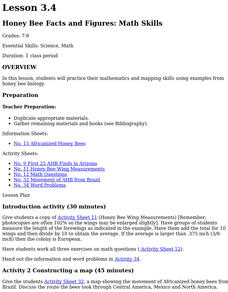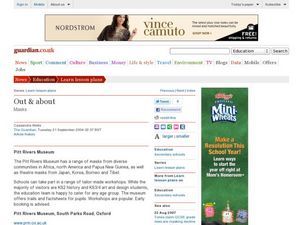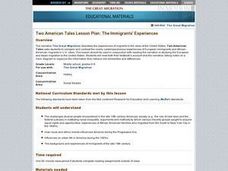Curated OER
Honey Bee Facts And Figures: Math Skills
Learners practice their mathematics and mapping skills using examples from honey bee biology. Discuss why the colonies were found in this pattern. They examine food and water in the area, and how many humans live in the area where...
Curated OER
Power to the Little People
Students explore the classic story theme of good versus evil as relayed in folk tales.
Curated OER
The Roots of the Afro-American Culture: The Artistic Approach
Students study the geographical structure of the continent of Africa. They discuss how and why there are so many tribes and kingdoms of Africa and dsicuss customs and traditions to determine how they come about in any ethnic group.
Curated OER
The Roaring Twenties
In this Roaring Twenties Era worksheet, young scholars review a chapter as they identify 5 vocabulary terms or individuals quotes, eliminate 4 false statements, and identify 2 themes from the era of great change in the United States.
Curated OER
Chinese Immigration
Students identify artifacts from Chinese immigrants that are common to other immigrant groups, describe how American society discriminated against the Chinese, describe contribution of Chinese immigrants to American society, discuss two...
Curated OER
Social Activism In The United States
Middle schoolers explore justice issues. In this social activism lesson, students watch "Social Activism in the United States," and then locate newspaper articles from the 1960's and 1970's about events during the era.
Curated OER
Out and About: Masks
Learners investigate the art of mask-making. In this cultural masks lesson, students may visit the Hancock or Horniman Museums in Britain online or in-person to discover details about cultural masks and give a try at making their own.
Curated OER
Two American Tales Lesson Plan: The Immigrants' Experiences
Learners examine the experiences of European immigrantion and African-American migration which happened at the same time in America. They compare and constrast the two experiences.
Curated OER
Immigration in the United States
Pupils examine the reasons why people leave their country to live in another. In groups, they use print and electronic resources to answer questions about where immigrants came from during different time periods and advice given to...
Facing History and Ourselves
Emmett Till: Examining the Choices People Made
The choices made by Roy Bryant and J.W. Millam, the men who murdered Emmett Till in 1955, are usually the ones people ponder when they examine the case. But other individuals made choices that contributed to the event and its subsequent...
Curated OER
Slave Ship: Carrier of Destiny
Fifth graders research topics related to slavery. They visit area museums, and the Arkansas Arts Council presents cultural experiences. They discuss and internalize the plight of people sold into slavery.
Curated OER
City Desk with Malcolm X
High schoolers view a film about civil rights and the role Malcolm X played in the civil rights movement. They create a timeling about the events that occured from segregation to integration. They discuss discrimination as well.
Curated OER
Jamestown Journey Part 4
Fourth graders review their prior knowledge from the previous lessons of this unit on Jamestown. After reading a novel, they examine and discuss the life of Pocahontas. Using the internet, they answer comprehension questions and write...
Curated OER
Jamestown Journey Part 3
Fourth graders study the economy of Jamestown. In this early settlers lesson, 4th graders read about the trade between the English and the natives in Jamestown. This lesson is part of a larger unit and coincides with the novel The Double...
Curated OER
Mrs. Katz and Tush
Students read Patricia Polacco's Mrs. Katz and Tush before comparing Jewish heritage with Black history using a Venn Diagram. They complete the diagram either as a whole group or in a small group setting. Next, they sample the Jewish...
Curated OER
Black History Month Cloze worksheet
In this Black History month cloze activity, students fill in ten blanks with the correct words from a word bank. Students read the text about Black History month.
Curated OER
Malcolm X
In this famous leaders worksheet, students read a passage about Malcolm X and then complete a variety of in-class and homework activities to support comprehension, including partner interviews, spelling, cloze, synonym matches, and...
Curated OER
The Motown Dynasty (1969-1980) Part 2
Students connect achievements of noted artists with their roles in the music industry. They identify many Black music industry leaders and their contributions with the Motown Sound.
Curated OER
Being Me in the Face of Adversity - Americans Who Stood Up for Their Beliefs
Students identify important Americans from the colonial, revolutionary and slavery periods who are noted for standing up for their beliefs in the face of peer disapproval. They identify the importance of music in motivating and...
Curated OER
On the Other Side of the Color Barrier: Segregation and the Negro Leagues
Young scholars study segregation that occurred in the past and that is currently occurring. In this equal rights lesson plan, students use primary source documents to student segregation of the past. In a culminating activity, young...
Curated OER
Worksheet #33 Questions - Boston Tea Party
In this Boston Tea Party quiz learning exercise, students test their historical knowledge with ten fill in the blank questions about various terms from the aforementioned subject.
Curated OER
Examining Passenger Lists Lesson Plan
Learners learn about the colonists that settled in the New World. In this famous explorers lesson, students learn about famous explorers and how they used to keep diaries about their travels. Learners read passenger lists from ships...
Curated OER
The Slave Trade
Students map and explore a possible slave trade route. In this slave trade mapping lesson, students calculate the distance and amount of time it would take for African slaves to arrive in America.
Curated OER
How Did You Get Here?
Students create a picture/poster or write a letter demonstrating their knowledge of why slavery was wrong. They describe what they think the travel was like for the Africans coming to America.

























